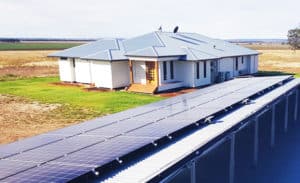
07 Dec The worldwide rise of energy storage
ZINC-BROMINE FLOW BATTERIES FOR RESIDENTIAL AND COMMERCIAL USE
The majority of the world’s power has mostly been consumed as quickly as it is made. All the extra power that was generated but not immediately used, was often wasted. With our constantly growing world population, and thus the huge need for energy, throwing away valuable energy is no longer an option. But that is not all. Climate change forces us to use more renewable energy. Unfortunately, renewable energy sources are variable, meaning that there is no constant supply.
The solution for these issues? Energy storage! There are a lot of promising battery solutions that are already being applied. The zinc-bromine flow batteries for instance, have a major influence and are currently booming worldwide.
What we already know about bromine as an energy storage enabler
Let’s talk bromine already gave insights about bromine as an energy storage enabler, and about the advantages of bromine-based flow-battery technologies. We also had a look at some cases where this innovative renewable energy saver has been put into practice, namely the Photon Farmer in the Netherlands and the Marine Corps Air station in Miramar, California. More examples of zinc-bromine battery applications keep arising. Let’s have a look at how this innovative technology is being spread all over the world.

Redflow’s ZCell battery for residential off-grid energy storage
Redflow is the Australian company behind the ZCell and the ZBM2 zinc-bromine flow batteries. The previous examples in the Netherlands and in California use the ZBM2 battery for commercial purposes. Today, we also see a growth in the implementations of ZCell batteries for residential use. Both Adrian Shand’s rural stone cottage and the Bates family’s off-grid new house use the world’s smallest zinc-bromine flow battery to generate power.
“Tree changers” chose energy efficient and conscious living
 Adrian and his partner dreamed about maintaining a city lifestyle in the beautiful countryside of Victoria, Australia. They found a lovely cottage with photovoltaic solar panels and a 1.5 kWh lead-acid battery already installed. But that did not suffice for the energy conscious couple.
Adrian and his partner dreamed about maintaining a city lifestyle in the beautiful countryside of Victoria, Australia. They found a lovely cottage with photovoltaic solar panels and a 1.5 kWh lead-acid battery already installed. But that did not suffice for the energy conscious couple.
By upgrading the solar panels and the battery, the property became truly grid-independent without use of a diesel backup generator. The superior energy storage system makes sure that the Victorian family does not have to worry about using too much energy and draining the battery. This is a necessity for Adrian, a sound engineer who requires multiple computers and professional musical amplifiers to work regularly.
This stable solution offers them the most energy for the least money. The energy storage system – consisting of 2 ZCell batteries – costs $56.000. Connecting the property to the main power would have cost about $200.000. This calculation and the fact that they would never have to pay another power bill, made the decision of living completely off-grid even easier!
The 2 Redflow 10 kilowatt-hour batteries deliver clean energy and are fully charged by the solar panels in just 4 hours on a sunny day. These 21 panels deliver 5.2 kilowatt peak. The batteries discharge all stored energy without damaging the battery and the storage capacity is warranted for 10 years (or 36.500 kWh of storage per battery).
The largest Australian residential energy storage system
The Bates family chose a similar energy solution for their new conscious home at Bardlomey. This property in the Maranoa region of Queensland is located about 2.7 kilometres from main power sources. Their 6-battery, 60 kilowatt-hour system ensures uninterrupted power, grid-independence and no more power bills or costs for connecting mains power to the house. The 400-square metre single-storey four-bedroom home has the largest Australian residential energy storage system to date for Redflow.
Besides the 6 Redflow ZCell batteries, the storage system consists of 2 Victron Quattro 48/10000 inverters/chargers (the same inverter that was used for the residential project in Victoria) and 72 Tindo 260-watt solar panels, with an 18.72-kilowatt peak capacity.


Why the ZCell battery storage solutions pay off
Both the Shand and the Bates family are impressed with the ZCell battery storage solutions. They did not have to compromise their way of living, and the professional follow-up and support ensures their peace of mind. By keeping in touch regularly, monitoring the system and continuously improving the technology, Redflow and Off-Grid Energy show themselves as trustworthy partners for respectively the production and the installation of the batteries.
For the Australian families Shand and Bates, the ZCells have one more extra plus. The battery solutions are designed in Australia, and they tolerate hot conditions. The systems can handle potential changeable weather, cooling houses one day and heating them up the next. This way, they are always at ease, no matter what the conditions are.
Redflow’s zinc-bromine production facilities in Thailand
With both residential and commercial uses all over the world, zinc-bromine flow batteries clearly have a large influence in the energy storage sector. Redflow is responsible for producing a large part of these redox flow batteries.
The Australian company is not only spreading its products worldwide. They plan on expanding their production process as well. To date, Redflow’s systems have been made in the US. The company is transitioning over to facilities in Thailand in order to be nearer to the target markets. Preparations are being made right now, the commercial operation is expected to begin by the end of 2017. The factory plans to produce 250 ZBM2 batteries per month, full production capacity could reach 30.000 kWh per year.
The broad range of energy storage solutions
 Besides zinc-bromine flow batteries, there are a lot of other interesting energy storage solutions. Pumped hydro energy storage is one of the modern grid-tied energy storage systems. Compressed air energy storage is quite similar, but pumps ambient air into a storage container instead of water. This idea is not as widely spread as the original water based system or as the conventional rechargeable lithium-ion battery solutions. Some systems like molten salt thermal storage are not as commercially used yet, but have potential for the future. Other ideas like non-lithium batteries work properly, but mostly stayed in the test phase. The flywheel system – a technology that stores electric energy as kinetic energy – is a neat but lesser-known method of smoothing out power delivery.
Besides zinc-bromine flow batteries, there are a lot of other interesting energy storage solutions. Pumped hydro energy storage is one of the modern grid-tied energy storage systems. Compressed air energy storage is quite similar, but pumps ambient air into a storage container instead of water. This idea is not as widely spread as the original water based system or as the conventional rechargeable lithium-ion battery solutions. Some systems like molten salt thermal storage are not as commercially used yet, but have potential for the future. Other ideas like non-lithium batteries work properly, but mostly stayed in the test phase. The flywheel system – a technology that stores electric energy as kinetic energy – is a neat but lesser-known method of smoothing out power delivery.
What are your experiences, expectations or opinions about renewable energy and energy storage?
Do not hesitate to share this article, to give your opinion and to start the conversation.
SOURCES
Victorian couple live off-grid dream with ZCell
Here are humanity’s best ideas on how to store energy
QLD home sets Redflow residential record
Australia’s Redflow targets 30MWh annual flow battery production at new Thai factory









No Comments